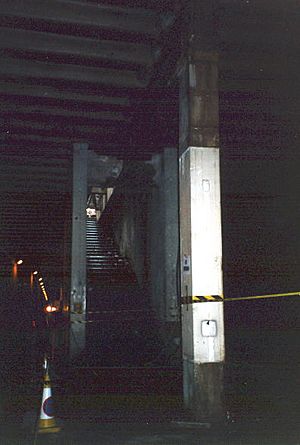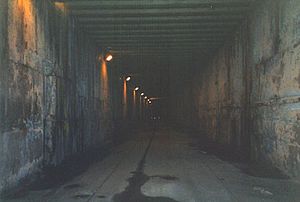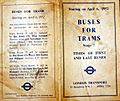Kingsway tramway subway facts for kids
The Kingsway tramway subway was a special underground tunnel in central London. It was built for the London County Council to connect two different tram systems, one in the "North Side" and one in the "South Side" of London. At first, only single-deck trams could use it. But between 1928 and 1931, the tunnel was made taller so that double-deck trams could fit. The subway closed in 1952. Today, part of the subway is used as the Strand Underpass for cars. The rest of the tunnel hasn't changed much and still has tram tracks inside! It's now a special historic building called a Grade II Listed structure.
Contents
Why the Tramway Subway Was Built
The London County Council had two separate tram systems. They really wanted to connect them. This would let them send trams from the "North Side" all the way to their main repair shop in Charlton, London in South East London. This was important for fixing and maintaining the trams.
In 1898, a decision was made to clear out some old, crowded areas in Holborn. New streets were built there. This gave them a perfect chance to add a tramway. In 1902, the Council decided to build the tramway underground. This subway would run from Theobalds Road in the north to the Victoria Embankment under Waterloo Bridge in the south. They planned for a tram line to continue above ground over Waterloo Bridge.
However, there were some legal issues. These problems delayed getting permission to build the subway and the tram route. They didn't get permission for the subway until 1906. They still weren't allowed to build the tram line over Waterloo Bridge. Also, the tunnel could only fit single-deck trams. This was because of a sewer pipe at the north end and the District Railway underground at the south end.
When trams left the subway at the south end, they could turn right towards Westminster Bridge. Or they could turn left for a short service from Bloomsbury to the Hop Exchange. This left-turn service didn't last long, and its tracks were removed in 1930.
At the north end, near Southampton Row, there was an open sloped area. It was about 52 meters long with a steep slope. The tracks went through special iron tubes under the Fleet sewer. Then they went up slightly to enter Holborn tramway station. From there to Aldwych tramway station, the subway had a steel roof. Since they didn't plan to run public services south of Aldwych at first, the tracks leading towards the Strand were used as a tram depot. They had equipment and pits for checking the trams.
Opening the Subway
The very first public tram went through the subway on 24 February 1906. It traveled from The Angel, Islington to Aldwych. The head of the Highways Committee held an opening party. The first trip took 10 minutes to reach Aldwych and 12 minutes to come back. This time included waiting for horse-drawn carts on the above-ground part of the route. On 16 November of the same year, the tram routes were made longer. They went north from The Angel to Highbury station. Special trams were used for this route. They were built from materials that couldn't easily catch fire. Wooden trams, like those on other routes, were not allowed in the subway.
In 1905, plans were made for another station at the south end of the tunnel. This station would have been under Wellington Street. But then a new tramway opened along the Embankment. So, it was decided to connect to that route instead, and the Wellington Street station was never built. A new sharp curve was built under Lancaster Place. This allowed trams to exit through the western side wall of Waterloo Bridge. A three-way junction was built with the main line. The eastern part of this junction, which led to Blackfriars, London, was removed during the upgrades in the 1930s.
Through Services and Upgrades

Trams started running all the way through the subway on 10 April 1908. They went from Highbury station to Tower Bridge and to Kennington Gate. There was a parade of six trams that went south from Holborn to Kennington. Then they went to Elephant and Castle to return through the subway to Angel. The Kennington service didn't make enough money. So, services were changed to go to Queens Road in Battersea instead. Because of a low bridge, this service could only use single-deck trams.
Tram drivers sometimes found it hard to climb the ramp north from Holborn tramway station. They would sometimes roll all the way back to the station! Drivers on routes through the tunnel had to have at least two years of experience on other tram services.
Tram services kept changing over the years. Especially when the tram lines over Blackfriars Bridge opened on 14 September 1909. In the 1920s, the London County Council realized that the subway needed to be able to carry double-deck trams to make money. In 1929, they decided to make the tunnel taller. They would increase the height to about 5 meters. This meant either raising the roof or digging the tunnel deeper.
Work began on 11 September 1929. The old iron tubes were replaced with a new steel roof. The sewer pipe was also moved. In some places, the track was lowered by about 1.5 meters. This meant the walls had to be strengthened with concrete. The tunnel closed after the last service on 2 February 1930. It reopened on 14 February 1930. Tram number 1931 was used on the new route 31. Public services started the next day. Both tram stations were also rebuilt. Trams now ran from Hackney to Wandsworth or Tooting, from Leyton to Westminster, from Highbury to Waterloo or Norbury, and from Archway to Kennington.
A weekend service was started between Highgate (Archway) and Downham through Brockley. This route closed in 1932. It was 26 kilometers long. This made it the longest tram route completely within the County of London.
Waterloo Bridge Rebuilding

In 1937, Waterloo Bridge was rebuilt. This meant the side entrance to the tramway had to be moved. A new entrance was built right in the middle, underneath the bridge. This new entrance opened on 21 November 1937.
End of the Trams
In 1933, a new company called the London Passenger Transport Board (LPTB) took over the London County Council trams. Soon after, the LPTB decided to replace all the trams in London with "more modern vehicles." The plan to remove trams started in 1935. Trams in many parts of London were replaced with trolleybuses. This plan continued quickly until 1940. In 1940, the last tram conversion happened before World War II. This left only the South London trams and subway routes 31, 33, and 35 still running. These subway routes were the only trams that ran into North London during the war.
A special trolleybus, number 1379, was built to test if trolleybuses could use the subway. This trolleybus had doors on both sides for this reason. However, the tests didn't work out. The trolleybuses would have had to run on battery power through the subway. They couldn't use overhead power because the tunnel wasn't tall enough for the wires.
In 1946, it was decided to replace all of London's remaining trams "as soon as possible." This time, they would be replaced by diesel buses instead of trolleybuses. The first subway route to close was route 31. It closed on 1 October 1950. Routes 33 and 35 closed at the end of service on Saturday, 5 April 1952. The very last public services through the subway were special trips that ran on Sunday, just after midnight. In the early hours of the next morning, all the remaining trams north of the subway were driven through the subway to the depots south of the River Thames.
Closure and New Uses
All the trams in London stopped running on 5 July 1952. After this, the tracks on the streets were removed. But most of the tracks inside the subway stayed in place. In 1953, London Transport used the tramway to store 120 unused buses and coaches. This was in case they were needed for the Coronation of Queen Elizabeth II.
However, ideas to turn the tramway subway into a car park or a movie studio didn't happen. So, it was rented out as a storage place starting in October 1957.
In June 1958, the London County Council suggested using the tunnel for light traffic coming from Waterloo Bridge. This would help reduce traffic jams where the bridge met Strand. In April 1962, they finally approved using part of the southern end of the subway for this purpose. Construction began in September of the same year. The subway opened to road traffic as the Strand Underpass on 21 January 1964.
The southern part of the old tunnel, between the Thames Embankment and the Strand Underpass, has been turned into a branch of the Buddha Bar chain of restaurants. This involved tearing down the pedestrian tunnels under Waterloo Bridge and a lot of building work under the bridge itself.
Images for kids
-
Kingsway Subway northern entrance in Southampton Row





